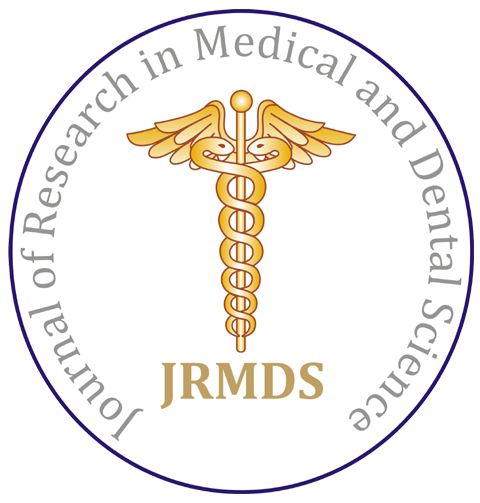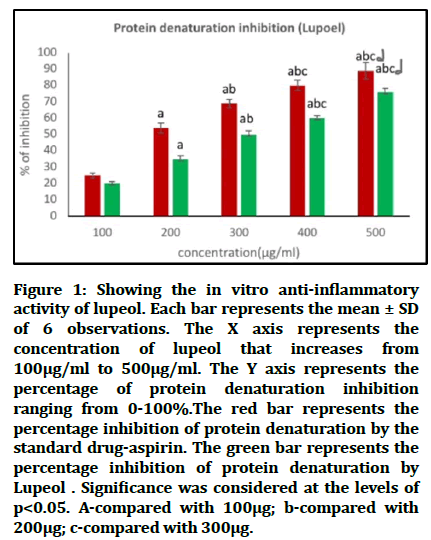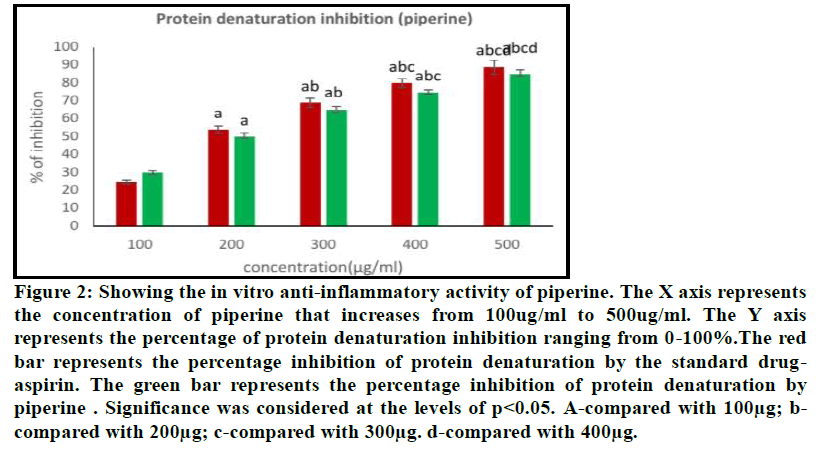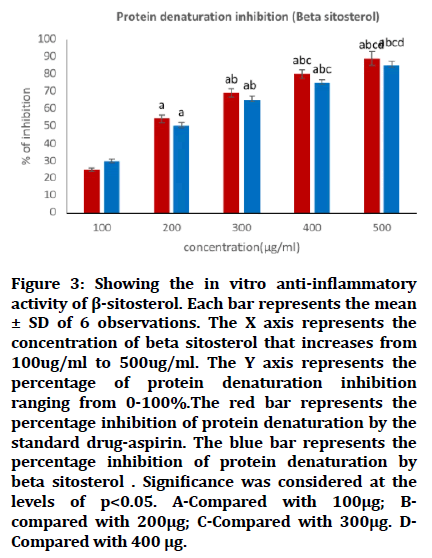Research - (2021) Volume 9, Issue 11
Comparative Evaluation of the Anti-Inflammatory Potential of Three Different Anti Diabetic Natural Compounds (Piperine, Lupeol, Beta Sitosterol)
Hooriyah, V Vishnu Priya*, J Selvaraj, Gayathri R and Kavitha S
*Correspondence: V Vishnu Priya, Department of Biochemistry, Saveetha Institute of Medical and Technical Sciences, Chennai, India, Email:
Abstract
Background: Anti-inflammatory drugs interfere in the pathophysiological process of inflammation, to minimize tissue damage and provide greater comfort to the patient. The anti-inflammatory drugs in the market today cause a lot of side effects. Hence, it is important to develop new naturally occurring anti-inflammatory drugs. Aim: To evaluate and compare anti-inflammatory potential of Lupeol, Piperine and Beta Sitosterol. Materials and methods: Protein denaturation inhibition Assay was performed. All the information and reported studies concerning lupeol, piperine and beta sitosterol were summarized from library and digital databases (e.g. Google Scholar, Sci-finder, PubMed, Springer, Elsevier, MDPI, Web of Science, etc.). Statistical analysis was done using ONE-WAY-ANOVA and Duncan Multiple Range Tests. Data were analysed to check the statistical significance between the groups. Results: The results have shown that the protein denaturation inhibition of lupeol, piperine and beta sitosterol happened in a dose dependent manner with concentrations ranging from 100-500 µg/ml. It is also observed that beta sitosterol has the maximum anti-inflammatory potential followed by piperine and then lupeol. Conclusion: Hence lupeol, piperine and beta sitosterol have good anti-inflammatory potentials with beta sitosterol having the best anti-inflammatory potential in comparison to Lupeol and Piperine. After further in vivo studies and clinical trials, they can be recommended as potential anti-inflammatory drugs in the market.
Keywords
Innovative technology, Anti-inflammatory, Beta sitosterol, Protein denaturation inhibition, Protease inhibition, Lupeol, Piperine, Novel method
Introduction
Inflammation is the immune response to dangerous stimuli, like pathogens, damaged cells, toxic substances or irradiation [1]. They act by removing injurious stimuli and initiating the process of healing [2]. Inflammatory response is the coordinated activation of signalling pathways which regulate the inflammatory mediator levels in tissues and inflammatory cells recruited from the bloodstream [3]. Anti-Inflammatory property refers to the ability of a substance to reduce inflammation or any of its 5 cardinal signs [4].
Through years of ingenious synthesis, many non-steroidal anti-inflammatory agents (NSAIDS) have been prepared and marketed .However, these drugs are known to provoke adverse effects such as gastrointestinal irritations, headaches, drowsiness and nausea [5]. Their prolonged use often leads to gastric intolerance, bone marrow depression, water and salt retention [6]. Hence, the search for alternative anti-inflammatory drugs mainly from natural herbs is required as they don’t have side effects and are cost-effective as well as easily accessible [7].
Mangoes, White cabbage, Lupin seeds, Strawberries, Figs and Olives are rich sources of lupeol [8]. It is a natural triterpenoids with immense anti-inflammatory potential targeting key molecular pathways which involves nuclear factor kappa B (NFκB), cFLIP, Fas, Kras, phosphatidylinositol-3-kinase (PI3K)/Akt and Wnt/β- catenin in a variety of cells [9].
Black peppers, white pepper and long peppers are good sources of piperine. Many laboratory studies suggest that piperine the main active compound in black pepper may effectively fight inflammation. For example in arthritis induced animal studies treatment with piperine resulted in less joint swelling and fewer blood markers of inflammation [10] and piperine also suppressed inflammation in the airways caused by asthma and seasonal allergies [11].
Beta sitosterol (BS) which is found abundantly in sesame seeds, flax seeds, almonds and cashews [12] is suggested to modulate the immune function, inflammation, and pain levels by controlling the production of inflammatory cytokines [13]. Beta Sitosterol lowers cholesterol levels and is precursor to an anabolic steroid [14]. Many research papers have shown that Beta Sitosterol has antiinflammatory effects on microglia and found that BS exerts anti-inflammatory effects mainly by inhibiting the activation of P38, ERK, and NF-κB pathways [15].
Though, the anti-inflammatory potentials of Lupeol, Piperine and Beta Sitosterol have been established in the past, this is the first ever research that compares the antiinflammatory of Lupeol , Piperine and Beta Sitosterol to each other as well as to the standard drug Aspirin conducted in vivo. Our team has extensive knowledge and research experience that has translate into high quality publications [16-35].
The aim of the current study was to evaluate and compare anti-inflammatory potential of Lupeol, Piperine and Beta sitosterol.
Materials and Methods
Chemicals
All the reagents and chemicals used in the present study were purchased from Sigma Chemical Company St. Louis, MO, USA; Invitrogen, USA; Eurofins Genomics India Pvt Ltd, Bangalore, India; New England Biolabs (NEB), USA; Promega, USA. Glyphosate was procured from Sigma Chemical Company St. Piperine, Lupeol and beta sitosterol purchased from Sigma Chemical Company St. Louis, MO, USA.
Inhibition of albumin denaturation
The anti-inflammatory activity of 3 different antidiabetic natural compounds was studied by using inhibition of albumin denaturation technique which was studied according to the methods of Mizushima, followed by minor modifications. The reaction mixture consisted of the test extracts and 1% aqueous solution of bovine serum albumin. The pH of the mixture was adjusted by using a small amount of 1N HCl for dissolving the mixture. The plant compounds (Piperine, Lupeol, beta sitosterol) with increase in concentration (100, 200,300,400, and 500μg/ml) were incubated at 37 ºC for 20 min and then later were heated to 51 º C for 20 min, once the samples cooled down, their turbidity was measured at 660nm. (UV Visible Spectrophotometer Model 371, Elico India Ltd) The experiment had been performed in triplicate. In this study, Aspirin was used as the standard anti-inflammatory drug.
Calculation: % Inhibition=100−((A1 -A2)/A0)*100)
Statistical analysis
The data were analysed statistically using one way analysis of variance (ONE-WAY ANOVA). Duncan Multiple range test was used to analyse the statistical significance between groups. P value of <0.05 was considered to be significant.
Discussion
In vitro anti-inflammatory activity of lupeol by protein denaturation inhibition On comparing the anti-inflammatory property of standard (Aspirin) and lupeol, the protein denaturation inhibition by lupeol increases in a dose dependent manner ranging from 20% to 75% with an increasing concentration from 100μg/ml to 500μg/ml (Figure 1).
Figure 1:Showing the in vitro anti-inflammatory activity of lupeol. Each bar represents the mean ± SD of 6 observations. The X axis represents the concentration of lupeol that increases from 100µg/ml to 500µg/ml. The Y axis represents the percentage of protein denaturation inhibition ranging from 0-100%.The red bar represents the percentage inhibition of protein denaturation by the standard drug-aspirin. The green bar represents the percentage inhibition of protein denaturation by Lupeol . Significance was considered at the levels of p<0.05. A-compared with 100μg; b-compared with 200μg; c-compared with 300μg.
In vitro anti-inflammatory activity of piperine by protein denaturation inhibition. On comparing the antiinflammatory property of standard (Aspirin) and piperine, The Protein Denaturation Inhibition by piperine increases in a dose dependent manner ranging from 20% to 85% in a concentration range of 100μg/ml to 500ug/ml (Figure 2).
Figure 2:Showing the in vitro anti-inflammatory activity of piperine. The X axis represents the concentration of piperine that increases from 100ug/ml to 500ug/ml. The Y axis represents the percentage of protein denaturation inhibition ranging from 0-100%.The red bar represents the percentage inhibition of protein denaturation by the standard drug-aspirin. The green bar represents the percentage inhibition of protein denaturation by piperine . Significance was considered at the levels of p<0.05. A-compared with 100μg; b-compared with 200μg; c-compared with 300μg. d-compared with 400μg.
In vitro anti-inflammatory activity of beta Sitosterol by protein denaturation inhibition. On comparing the antiinflammatory property of standard and beta sitosterol, The Protein Denaturation Inhibition by beta sitosterol happens in a dose dependent manner ranging from 20% to 87% in a dose dependent manner as the concentration of beta sitosterol increases from 100ug/ml to 500ug/ml (Figure 3).
Figure 3:Showing the in vitro anti-inflammatory activity of ß-sitosterol. Each bar represents the mean ± SD of 6 observations. The X axis represents the concentration of beta sitosterol that increases from 100ug/ml to 500ug/ml. The Y axis represents the percentage of protein denaturation inhibition ranging from 0-100%.The red bar represents the percentage inhibition of protein denaturation by the standard drug-aspirin. The blue bar represents the percentage inhibition of protein denaturation by beta sitosterol . Significance was considered at the levels of p<0.05. A-Compared with 100μg; Bcompared with 200μg; C-Compared with 300μg. DCompared with 400 μg.
The results have shown that the protein denaturation inhibition of lupeol, piperine and beta sitosterol occurs in a dose dependent manner with concentrations ranging from 100-500 μg/ml. In comparison beta sitosterol exhibited a potent anti-inflammatory potential with an Ic50 of 210μg/ml followed by piperine with an Ic50 of 240μg/ml and then lupeol with an Ic50 of 320μg/ml
Discussion
The purpose of our study was to determine and compare the Anti-inflammatory potential of three different antidiabetic plant derived compounds (Piperine, Lupeol, beta sitosterol). Since NSAIDS (Non-Steroidal Anti- Inflammatory Drugs) are synthetic, they tend to have side effects like heart burns, vomiting, drowsiness and gastrointestinal problems. Hence, there is a need for developing natural, plant based products in the market as they have least to no side effects and are cheaper in comparison to NSAIDS. In the present study, it has been observed that beta sitosterol has shown maximum protein denaturation inhibition which makes it the best anti-inflammatory compound followed by piperine and then lupeol. With further studies and trials Lupeol, Piperine and Beta Sitosterol can be recommended as potential anti-inflammatory drugs in the market.'
From the results of the present study, it is observed that Lupeol has a good anti-inflammatory potential. In a previous study it was observed that, Lupeol and lupeol linoleate have shown a significant reduction in paw swelling by 39% and 58%, respectively, in adjuvant arthritis induced in rats which proved anti-inflammatory properties of lupeol. Paw edema had been induced by carrageenan and dextran in male swiss mice, and the inflammation reduced 30minutes after the administration of Lupeol Acetate [36,37]. In the chronic model of granuloma pouch in rats, lupeol exhibited 33% reduction in granuloma weight. In the arthritis model, lupeol exhibited 29% inhibition after 21 days. This showed that lupeol isolated from Strobilanthes callosus exhibited significant anti-inflammatory and antiarthritic activities [36]
In the present study, it was observed that Piperine has a very good anti-inflammatory potential. Similarly in another previous study, Piperine inhibited the expression of IL6 and MMP13 and also reduced the PGE2 production in a dose dependant manner at concentrations from 10 to 100 μg/ml. This suggested that piperine has antiinflammatory, and antiarthritic effects in an arthritis induced animal model [38]. Also, piperine acts by mast cell-stabilizing activity, exhibits anti-inflammatory activity, thereby providing an effective treatment for Allergic Rhinitis [39].
In the present study, it is observed that Beta Sitosterol has an excellent anti-inflammatory potential. Similarly, it had been observed that Beta-sitosterol inhibited the expression of vascular adhesion molecule 1 and intracellular adhesion molecule 1 in TNF-alphastimulated Hirschsprung-associated enterocolitis as well as the binding of U937 cells to TNF-alpha-stimulated Hirschsprung-associated enterocolitis and reduces the phosphorylation of nuclear factor-kB p65. In the rat paw edema test previously, an inhibitory effect was found which goes from 50-70% which had been exhibited by beta-sitosterol [40]. In the same line with our findings, it was found that beta sitosterol decreased the activation of NFkB transcription factor in PMA-stimulated macrophage cells which suggest the anti-inflammatory action is mediated [41].
Since the extracts were natural, they could easily be destroyed and also lost in culture. But as they were all plant derived compounds. They are easily accessible and are cheaper than synthetic chemical compounds. With further in-vitro, in-vivo and clinical studies, these plant derived compounds could quench the thirst of herbal products in the market. The anti inflam properties of lupeol, piperine and beta sitosterol could be attributed to the factors that they are triterpenoids, alkaloids and phytosterols respectively that have proven to have antiinflammatory properties in previous findings.
Limitations-Since they are all natural products, they might not be found everywhere and may get damaged during culture as well. Future scope-All these three drugs may be recommended for the treatment of inflammationmediated development of diabetes and associated complications. However, among three drugs analysed beta sitosterol can be prioritized as it proved to possess better efficacy.
Conclusion
Our present study clearly indicates that all the three natural compounds have ability in inhibiting the protein denaturation among which the beta sitosterol exhibited the maximum protective effect followed by piperine and lupeol. This study concludes that all these three drugs may be recommended for the treatment of inflammationmediated development of diabetes and associated complications. However, among three drugs analyzed beta sitosterol can be prioritized as it proved to possess better efficacy.
Conflict of Interest
The authors hereby declare that there is no conflict of interest in this study.
Acknowledgement
The authors express their gratitude to Saveetha Dental College & Hospitals for supporting and for successful completion of this project.
Source of Funding
1. The present project is funded by
2. Saveetha Institute of Medical and Technical Sciences, Saveetha Dental College and Hospitals, Saveetha University, Maple Leaf construction and Projects
Author Contribution
Hooriyah: Contributed in designing the study, execution of the project, statistical analysis, manuscript drafting.
V Vishnupriya: Contributed in study design, guiding the research work, manuscript correction.
J Selvaraj, Gayathri R, Kavitha S: Study design, statistical analysis, manuscript proofreading and correction.
References
- Medzhitov R. Inflammation 2010: New Adventures of An Old Flame. Cell 2010; 140:771-6.
- Ferreroâ?Miliani L, Nielsen OH, Andersen PS, et al. Chronic inflammation: Importance of NOD2 and NALP3 In Interleukinâ?1β Generation. Clin Expe Immunol 2007; 147:227-35.
- Lawrence T. The nuclear factor NF-Κb pathway in inflammation. Cold Spring Harbor Perspectives Biol 2009; 1:001651.
- Sun Y, Blieden C, Merritt BY, et al. Hemophagocytic lymphohistiocytosis and myelodysplastic syndrome: A case report and review of the literature. J Med Case Rep 2021; 15:98.
- Chan J, Haroon N. Treatment: NSAIDs . Oxford Med Online 2016.
- Saxena RS, Gupta B, Saxena KK, et al. Study of anti-inflammatory activity in the leaves of Nyctanthes arbor tristis Linn: An Indian medicinal plant. J Ethnopharmaco 1984; 11:319-330.
- Wong SH, Chan FK. Adverse Effects of NSAIDs in the gastrointestinal tract: Risk factors of gastrointestinal toxicity with NSAIDs. Springer Cham 2016; 45-59.
- Lerma-Torres JM, Navarro-Ocaña A, Calderón-Santoyo M, et al. Preparative scale extraction of mangiferin and lupeol from mango (Mangifera indica L.) leaves and bark by different extraction methods. J Food Sci Techno 2019; 56:4625-31.
- Sankaran M. Lupeol: An ubiquitous compound for multiple ailments. RA J Applied Res 2017.
- Rinkunaite I, Simoliunas E, Alksne M, et al. Anti-inflammatory effect of different curcumin preparations on adjuvant-induced arthritis in rats. BMC Compl Med Therapies 2021; 21:1-2.
- Wang Y, Sun H, Zhang J, et al. Streptozotocin-induced diabetic cardiomyopathy in rats: Ameliorative effect of PIPERINE via Bcl2, Bax/Bcl2, and caspase-3 pathways. Biosci Biotech Biochem 2020; 84:2533-44.
- Pacheco DF, González Ceballos L, Castro AZ, et al. Synthesis of new steroidal carbamates with plant-growth-promoting activity: Theoretical and experimental evidence. Int J Mol Sci 2021; 22.
- Liao PC, Lai MH, Hsu KP, et al. Identification of β-sitosterol as in vitro anti-inflammatory constituent in Moringa oleifera. J Agri Food Chem 2018; 66:10748-59.
- Saeidnia S. The story of beta-sitosterol- A review. Euro J Medi Plants 2014; 4:590–609.
- Sun Y, Gao L, Hou W, et al. β-Sitosterol alleviates inflammatory response via inhibiting the activation of ERK/p38 and NF-κB pathways in LPS-Exposed BV2 Cells. BioMed Res Int 2020; 1–10.
- Wu F, Zhu J, Li G, et al. Biologically synthesized green gold nanoparticles from Siberian ginseng induce growth-inhibitory effect on melanoma cells (B16). Artif Cells Nanomed Biotechnol 2019; 47:3297–305.
- Chen F, Tang Y, Sun Y, et al. 6-shogaol, a active constiuents of ginger prevents UVB radiation mediated inflammation and oxidative stress through modulating NrF2 signaling in human epidermal keratinocytes (HaCaT cells). J Photochem Photobiol 2019; 197:111-518.
- Li Z, Veeraraghavan VP, Mohan SK, et al. Apoptotic induction and anti-metastatic activity of eugenol encapsulated chitosan nanopolymer on rat glioma C6 cells via alleviating the MMP signaling pathway. J Photochem Photobio 2020; 203:111-773.
- Babu S, Jayaraman S. An update on β-sitosterol: A potential herbal nutraceutical for diabetic management. Biomed Pharmacother 2020; 131:110-702.
- Malaikolundhan H, Mookkan G, Krishnamoorthi G, et al. Anticarcinogenic effect of gold nanoparticles synthesized from Albizia lebbeck on HCT-116 colon cancer cell lines. Artif Cells Nanomed Biotechnol 2020; 48:1206–1213.
- Han X, Jiang X, Guo L, et al. Anticarcinogenic potential of gold nanoparticles synthesized from Trichosanthes kirilowii in colon cancer cells through the induction of apoptotic pathway. Artif Cells Nanomed Biotechnol 2019; 47:3577–84.
- Gothai S, Muniandy K, Gnanaraj C, et al. Pharmacological insights into antioxidants against colorectal cancer: A detailed review of the possible mechanisms. Biomed Pharmacother 2018; 107:1514–1522.
- Veeraraghavan VP, Hussain S, Balakrishna JP, et al. A comprehensive and critical review on ethnopharmacological importance of desert truffles: Terfezia claveryi, terfezia boudieri, and tirmania nivea. Food Reviews Int 2021; 1–20.
- Sathya S, Ragul V, Veeraraghavan VP, et al. An in vitro study on hexavalent chromium [Cr(VI)] remediation using iron oxide nanoparticles based beads. Environ Nanotechnol Monitoring Management 2020; 14:100333.
- Yang Z, Pu M, Dong X, et al. Piperine loaded zinc oxide nanocomposite inhibits the PI3K/AKT/mTOR signaling pathway via attenuating the development of gastric carcinoma: In vitroandin vivostudies. Ara J Chem 2020; 13:5501–16.
- Rajendran P, Alzahrani AM, Rengarajan T, et al. Consumption of reused vegetable oil intensifies BRCA1 mutations. Crit Rev Food Sci Nutr 2020; 1–8.
- Barma MD, Muthupandiyan I, Samuel SR, et al. Inhibition of Streptococcus mutans, antioxidant property and cytotoxicity of novel nano-zinc oxide varnish. Arch Oral Biol 2021; 126:105-132.
- Samuel SR. Can 5-year-olds sensibly self-report the impact of developmental enamel defects on their quality of life? Int J Paediatr Dent 2021; 31:285–286.
- Samuel SR, Kuduruthullah S, Khair AMB, et al. Dental pain, parental SARS-CoV-2 fear and distress on quality of life of 2 to 6 year-old children during COVID-19. Int J Paediatr Dent 2021; 31:436–41.
- Tang Y, Rajendran P, Veeraraghavan VP, et al. Osteogenic differentiation and mineralization potential of zinc oxide nanoparticles from Scutellaria baicalensis on human osteoblast-like MG-63 cells. Materials Sci Eng 2021; 114:111-656.
- Yin Z, Yang Y, Guo T, et al. Potential chemotherapeutic effect of betalain against human non-small cell lung cancer through PI3K/Akt/mTOR signaling pathway. Environ Toxicol 2021; 36:1011–20.
- Veeraraghavan VP, Periadurai ND, Karunakaran T, et al. Green synthesis of silver nanoparticles from aqueous extract of Scutellaria barbata and coating on the cotton fabric for antimicrobial applications and wound healing activity in fibroblast cells (L929). Saudi J Biol Sci 2021; 28:3633–40.
- Mickymaray S, Alfaiz FA, Paramasivam A, et al. Rhaponticin suppresses osteosarcoma through the inhibition of PI3K-Akt-mTOR pathway. Saudi J Biol Sci 2021; 28:3641–3649.
- Teja KV, Ramesh S. Is a filled lateral canal–A sign of superiority? J Den Sci 2020; 15:562–3.
- Kadanakuppe S, Hiremath S. Social and behavioural factors associated with dental caries experience among adolescent school children in Bengaluru City, India. Bri J Med Medi Res 2016; 14:1–10.
- Sarpate R, Tupkari S. Evaluation of anti-inflammatory activity of Strobilanthus callosus Nees and Strobilanthus ixiocephala Benth. Int J Green Phar 2012; 16:199.
- Geetha T, Varalakshmi P. Anti-inflammatory activity of lupeol and lupeol linoleate in rats. J Ethnopharmacol. 2001; 15:77–80.
- Sabina EP, Nagar S, Rasool M. A role of piperine on monosodium urate crystal-induced inflammation—An experimental model of gouty arthritis. Inflammation 2011; 34:184–92.
- Settipane RA. Other Causes of rhinitis: Mixed rhinitis, rhinitis medicamentosa, hormonal rhinitis, rhinitis of the elderly, and gustatory rhinitis. Immuno Aller Clin North Am 2011; 31:457–67.
- Ribeiro AEAS, Soares JMD, Silva HAL, et al. Inhibitory effects of Morus nigra L. (Moraceae) against local paw edema and mechanical hypernociception induced by Bothrops jararacussu snake venom in mice. Biomed Pharmacother 2019; 111:1046–56.
- Lewit RA, Veras LV, Cowles RA, et al. Reducing underdiagnosis of hirschsprung-associated enterocolitis: A novel scoring system. J Surg Res 2021; 261:253–260.
Author Info
Hooriyah, V Vishnu Priya*, J Selvaraj, Gayathri R and Kavitha S
Department of Biochemistry, Saveetha Institute of Medical and Technical Sciences, Chennai, IndiaCitation: Hooriyah, V Vishnu Priya, J Selvaraj, Gayathri R, Kavitha S, Comparative Evaluation of the Anti-Inflammatory Potential of Three Different Anti Diabetic Natural Compounds (Piperine, Lupeol, Beta Sitosterol), J Res Med Dent Sci, 2021, 9(11): 230-234
Received: 09-Sep-2021 Accepted: 08-Nov-2021



